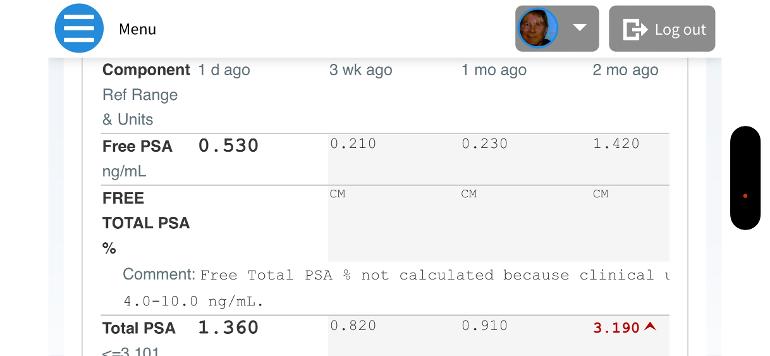PSMA Scan results from March 5, 2024
ONCOLOGIC FINDINGS:
History of metastatic castrate resistant prostate cancer status post interval radiation therapy to T3 and right 3rd rib with:
- Post surgical changes prior prostatectomy
- Essentially resolved prior PSMA uptake in right 3rd posterior rib and T4 vertebral body sclerotic lesions.
- Increased size sclerotic lesion with new low to intermediate PSMA uptake in the right femoral neck (5-469).
- Faint sclerotic changes in the right pubic bone, right acetabulum without PSMA uptake consistent with treated metastatic disease.
-New ill-defined sclerosis in the superior L2 vertebral body (5-332), focal sclerosis in the right iliac wing (5-410) and left 6th rib (5-241) with low PSMA activity.
INDETERMINATE FINDINGS:
New punctate sclerosis in the manubrium (16-120),
ADDITIONAL FINDINGS:
PET:
Physiologic PSMA uptake is noted in the lacrimal and salivary glands, nasopharynx, vocal cords, gastrointestinal tract (especially duodenum), spleen, liver, both kidneys, ureters and the urinary bladder, and testes.
For SUV reference:
SUVmean/max parotid/salivary glands 11.9/14.6 SUVmean/max right hepatic lobe 2.8/4.3
SUVmean/max descending thoracic aorta (level carina) 1.1/1.6
PSMA-expression score*:
High (3): SUV parotid/salivary glands Intermediate (2): SUV liver
Low (1): SUV blood pool
CT:
HEAD AND NECK: Thyroid atrophy
CHEST:
Lungs: Stable scattered pulmonary micronodules. Bilateral lower lobes reticular scarring, pleural-based architectural distortion and atelectasis. Lymph nodes and Mediastinum: Subcentimeter intrathoracic lymph nodes. Ovoid calcified lesions in the anterior mediastinum, stable. Pleura: Left upper lobe calcified pleural plaque.
Cardiovascular: Mild to moderate atherosclerotic calcifications of the
Heggstad, Glen MRN: 1476933 ACC: 52698650 PET CT Body with Diagnostic CT of the neck chest abd Pelvis w/IV
contrast
Page 2 of 5 •
thoracic aorta and coronary arteries . Left superior vena cava,draining into coronary sinus.
Other: Mild bilateral gynecomastia.
ABDOMEN/PELVIS:
Liver: Stable punctate calcification in the caudate likely represents a prior granulomatous disease.
Gallbladder and bile ducts: Unremarkable.
Spleen: Stable punctate calcification in the spleen likely represent prior granulomatous disease
Pancreas, adrenals: Unchanged mild prominence of the main pancreatic duct, measuring up to 6 mm.
Kidneys and ureters: Stable left simple appearing renal cysts. Atrophic left kidney with cortical scarring. Mild left pelvocaliectasis without frank hydronephrosis.
Bowel: Scattered colonic diverticula. Jejunal diverticulum.
Bladder and reproductive organs: As above.
Lymph nodes: As above.
Peritoneum: Unremarkable.
Vessels: Mild to moderate atherosclerosis.
Abdominal wall: Postsurgical changes in the anterior abdominal wall. Status post bilateral inguinal hernia repair.
MUSCULOSKELETAL:
As above. Multilevel degenerative changes of the thoracolumbar spine. Chronic rib fractures involving the right posterior fifth and sixth ribs. Retention sutures in the left proximal humerus Stable L5 spinous process hardware in place.
Impreesion:
History of metastatic castrate resistant prostate cancer status post interval radiation therapy to T3 and right 3rd rib with:
- Post surgical changes prior prostatectomy
- Essentially resolved prior PSMA uptake in right 3rd posterior rib and T4 vertebral body sclerotic lesions.
- Increased size sclerotic lesion with new low to intermediate PSMA uptake in the right femoral neck (5-469).
- Faint sclerotic changes in the right pubic bone, right acetabulum without PSMA uptake consistent with treated metastatic disease.
-New ill-defined sclerosis in the superior L2 vertebral body (5-332), focal sclerosis in the right iliac wing (5-410) and left 6th rib (5-241) with low PSMA activity.
INDETERMINATE FINDINGS:
New punctate sclerosis in the manubrium (16-120),
ADDITIONAL FINDINGS:
PET:
Physiologic PSMA uptake is noted in the lacrimal and salivary glands, nasopharynx, vocal cords, gastrointestinal tract (especially duodenum), spleen, liver, both kidneys, ureters and the urinary bladder, and testes.
For SUV reference:
SUVmean/max parotid/salivary glands 11.9/14.6 SUVmean/max right hepatic lobe 2.8/4.3
SUVmean/max descending thoracic aorta (level carina) 1.1/1.6
PSMA-expression score*:
High (3): SUV parotid/salivary glands Intermediate (2): SUV liver
Low (1): SUV blood pool
CT:
HEAD AND NECK: Thyroid atrophy
CHEST:
Lungs: Stable scattered pulmonary micronodules. Bilateral lower lobes reticular scarring, pleural-based architectural distortion and atelectasis. Lymph nodes and Mediastinum: Subcentimeter intrathoracic lymph nodes. Ovoid calcified lesions in the anterior mediastinum, stable. Pleura: Left upper lobe calcified pleural plaque.
Cardiovascular: Mild to moderate atherosclerotic calcifications of the
thoracic aorta and coronary arteries . Left superior vena cava,draining into coronary sinus.
Other: Mild bilateral gynecomastia.
ABDOMEN/PELVIS:
Liver: Stable punctate calcification in the caudate likely represents a prior granulomatous disease.
Gallbladder and bile ducts: Unremarkable.
Spleen: Stable punctate calcification in the spleen likely represent prior granulomatous disease
Pancreas, adrenals: Unchanged mild prominence of the main pancreatic duct, measuring up to 6 mm.
Kidneys and ureters: Stable left simple appearing renal cysts. Atrophic left kidney with cortical scarring. Mild left pelvocaliectasis without frank hydronephrosis.
Bowel: Scattered colonic diverticula. Jejunal diverticulum.
Bladder and reproductive organs: As above.
Lymph nodes: As above.
Peritoneum: Unremarkable.
Vessels: Mild to moderate atherosclerosis.
Abdominal wall: Postsurgical changes in the anterior abdominal wall. Status post bilateral inguinal hernia repair.
MUSCULOSKELETAL:
As above. Multilevel degenerative changes of the thoracolumbar spine. Chronic rib fractures involving the right posterior fifth and sixth ribs. Retention sutures in the left proximal humerus Stable L5 spinous process hardware in place.
IMPRESSION:
1. History of metastatic prostate cancer with increased size sclerotic lesion with new focal PSMA uptake in the right femoral neck and new PSMA avid sclerotic lesions at L2, the right iliac bone and left 6th rib, consistent with active metastatic disease.
2. New punctate sclerosis in the manubrium, indeterminate. Recommend close attention on follow-up.
Molecular Imaging TNM classification*: mi T0 N0 M1b(diss)
